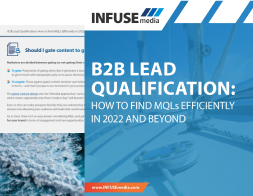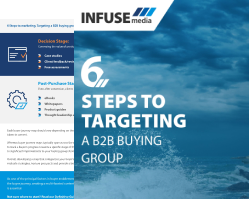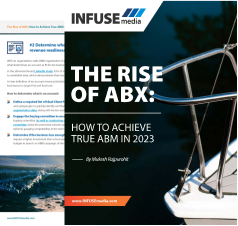MQAs vs MQLs: How to Identify the Best Leads for ABX

- Introduction
- What are Marketing Qualified Accounts (MQAs) and how do they differ from Marketing Qualified Leads (MQLs)?
- What is Account Based Marketing (ABM)?
- What are the potential challenges of MQLs?
- The benefits of MQAs
- How to utilise MQAs
- What is ABX in marketing?
- The challenges of Account Based Experience (ABX)
- The benefits of Account Based Experience (ABX)
- Your guide to implementing Account Based Experience (ABX)
- Conclusion
Introduction
In the information-driven environment of the B2B sector, where businesses have endless amounts of data at their fingertips, it is a necessity for marketers to grasp the opportunity of using this data to hone their focus and reduce costs by qualifying their leads. By running leads through carefully considered lead scoring criteria, companies can discover the leads that are most likely to become clients, i.e. “Marketing Qualified Leads” (MQLs).
MQLs have been a staple within lead scoring for B2B and B2C marketing for the last few decades but with the increasing popularity of Account Based Marketing (ABM), the approach of qualifying leads is beginning to change. According to Hubspot’s 2023 Sales Trend Report, more than half (56%) of sales representatives feel that lead quality has stayed the same or worsened from 2021 to 2022, which demonstrates the need for marketers to change their lead scoring methodology, ushering in the use of the lesser-known Marketing Qualified Accounts (MQAs).
What is lead scoring?
Lead scoring is the process of ranking leads according to specific criteria from a chosen scoring model that measures their value and probable sales funnel stage. This determines the type of content that is delivered to the lead, the frequency of engagement, and the point at which a sales representative will contact them directly.
What is a lead score?
This is the score given to a lead that ranks its value and position within the sales funnel.
What are Marketing Qualified Leads (MQLs)?
Gartner defines a MQL as “a potential customer that has been reviewed by the marketing team and satisfies the criteria necessary to be passed along to the sales team.”
What are Marketing Qualified Accounts (MQAs) and how do they differ from Marketing Qualified Leads (MQLs)?
While MQAs also represent a collection of leads that are most likely to become clients, the key difference compared to MQLs is that these leads are filtered for companies rather than individuals. Therefore, MQA profiles represent a group of individuals from the same company that constitute a single account.
When it comes to how MQLs and MQAs are determined, the data from analytics tools, Client Relationship Management (CRM) software, lead generating activities (such as gated content and webinars), and predictive lead scoring software are integral
to creating a full picture for both MQLs and MQAs. This includes a plethora of marketing segmentation datasets, such as demographic, geographic, firmographic, behavioural, and psychographic information which will be used to both qualify the leads with a predetermined lead scoring model and personalise every engagement thereafter.
Both MQLs and MQAs play an important role within the sales cycle as they will inform the direction of campaigns, content topics, marketing channels that content will be served on, and nurturing cadences once they have been qualified.
This means that MQLs and MQAs are paramount in more than just the nurturing stage of the sales cycle, as the pain points, goals, needs, and preferences of these qualified leads will determine how the offer is presented and objections are overcome, as well as the timing and manner of closing the sale itself.
Once MQLs and MQAs have reached the point in the sales funnel where they are ready to interact with the sales team directly and have a greater urgency to buy, they become Sales Qualified Leads (SQLs).
There has been some confusion within the B2B space surrounding the use of MQLs vs SQLs, particularly in companies where the sales and marketing teams are heavily siloed and each department has its own lead scoring best practices. This can be avoided with a greater emphasis on sales and marketing team cohesion and a shared lead rating system of qualified sales leads.
In recent years, the evolution of B2B targeting and lead scoring systems has popularised ABM, particularly among B2B marketers, due to its more streamlined nature and capability for personalising campaigns. In fact, according to HubSpot’s State of Marketing Trends Report 2022, the use of ABM increased by 15% from 2020 to 2021 with 70% of marketers reporting that they used ABM.
Is your current lead qualification strategy not achieving expected outcomes? Discover how to find MQLs efficiently with our B2B Lead Qualification guide.

What is Account Based Marketing (ABM)?
ABM is a marketing approach that focuses its attention on key accounts or businesses in place of a broader focus on individual prospects. This is an especially apt approach In the B2B landscape where the collective decision of buying committees—and not single individuals—determine purchases.
As mentioned before, an ABM strategy can be highly personalised, as well as streamline marketing budgets for targeting leads. The positive effects of personalisation on conversion rate and client retention are becoming increasingly obvious in the B2B arena and it is no longer only relevant to B2C. In Salesforce’s 2020 State of the Connected Customer Report, it was reported that 66% of surveyed clients expected companies to understand their unique needs and expectations, yet the same percentage reported that they generally felt that they were treated like numbers.
These findings have carried over to the B2B space and the results of ABM in committed businesses speak for themselves: Multiple reports from as far back as 2016 to more recent years have demonstrated a direct increase in revenue associated with ABM. According to Forrester’s 2019 report on ABM Maturity, 62% of participants reported that they had measured a positive impact since adopting ABM. In the same report, marketers also strongly agreed that personalised content (56%) and advanced data management (43%) were key to their ABM success.
However, a recent survey by DemandMetric and Integrate reveals that 53% of B2B marketers will spend less in ABM in 2023. This downturn is believed to be the direct result of a lack of knowledge on the correct implementation of ABM—which results in poor performance—rather than a failing of the strategy itself. This presents a unique opportunity for companies willing to put resources into developing a successful and highly functional ABM strategy, as they will undoubtedly stand out from competitors who choose not to.
As more marketers began to adopt ABM and change the way they targeted prospects, it also became necessary to change the lead scoring process, which led to the creation and subsequent use of MQAs, which also have a high emphasis on the use of data and personalised content.
What are the potential challenges of MQLs?
MQL marketing in a B2B setting can often pose challenges due to the unique nature of the leads and the amount of lead nurturing required.
Determining the lead scoring process
One of the biggest challenges marketers face when utilising MQLs is deciding how lead scoring works for the specified target market and creating a lead ranking system that is correctly segmented and representative of the associated buyer personas.
This is especially difficult when the sales and marketing departments have vastly different views on what constitutes relevant marketing qualified lead criteria or when the departments are heavily siloed with minimal communication.
A 2019 Gartner study found that 70% of leads are lost from poor follow-up due to the sales team not knowing the correct leads to contact. In environments where the marketing and sales teams are closely collaborating and ensuring that their campaigns and approach are always data-led to allow for pivots when necessary, this becomes less of a problem.
Analysing the lead ranking
When it comes to lead scoring analysis, MQL models can be slightly more prone to bias. This is due to the fact that it is often more challenging to accurately gauge the specific touchpoints (or sequence of events) that qualify individuals as “qualified leads”. Additionally, if marketing and sales departments are not well aligned, they may each have their own opinions on what qualities qualify a lead as a good fit for the business's solution. With MQA models, the collective decisions within a single account as well as the detailed data particular to that account’s needs and behaviour will assist in making those touchpoints much clearer. MQA data is more detailed as it draws on multiple individuals' market segmentation data sets in addition to the data from the account itself.
Tracking lead scoring touchpoints
Defining the touchpoints that qualify leads can also prove a challenge with MQLs, particularly in relation to the dark funnel and the comparative difficulty in tracking an individual versus a group of individuals who collectively form a more detailed picture of the account’s readiness for further engagement.
The dark funnel can be defined as the part of the sales funnel that is completely untracked by analytics software and CRMs. This includes the use of direct messaging apps where people share links and websites with each other, word-of-mouth where people direct their colleagues to a particular company or service, social media posts, and SMS which, even when promotional in nature, can be quite challenging to track.
A broader, less personalised focus
As MQLs consist of individuals, the focus of campaigns, content, and other engagements, even when well-aligned with the Ideal Client Profile (ICP), will be broader and less personalised than MQAs. This means that the budget will need to stretch further for a more varied approach.
The lack of personalisation may also create challenges for the sales department: In Salesforce’s 2020 State of the Connected Customer Report, 70% of consumers reported that a company understanding how they use products and services is very important to winning their business. Therefore without a detailed understanding of clients (such as how they use their products), sales teams will not be able to personalise their approach sufficiently to win their business.
Tracking clients through the funnel
When targeting B2B businesses, it is their buying committee members who will be engaging with your content and ultimately deciding the purchase of your solutions.
With MQLs, this can make tracking your leads accurately more difficult, as multiple members of the same company may be at different points in the sales funnel. This may cause members who are not part of the buying committee to be targeted in addition to inaccurately identifying where the company is in the sales process.
Prioritising the nurturing of MQLs could also cause the neglect of leads in other parts of the funnel (especially when this may be excluding sales-ready leads through inaccurate criteria).
MQLs often do not have buying intent
Due to the limited scope of qualifying MQLs, many of the identified individuals do not have buying intent. Even in the event that they match a company’s ICP while their intent data shows interest, the depth of that interest is hard to quantify on an individual basis. This is why MQLs on the whole often do not convert well.
A good MQL conversion rate is 13%, while a standard MQA conversion rate is closer to 20%. Additionally, those that do convert may be price sensitive as they were likely doing comparison shopping when your analytics flagged them as sales ready. Due to the lack of personalisation and less emphasis on after-sales satisfaction, MQLs will also have a much higher churn rate than MQAs. According to a survey by Marketo, almost 85% of marketers said ABM provided significant benefits to retaining and expanding existing client relationships.
All of these aspects of MQLs have led many marketers to believe that they are an outdated metric within B2B lead scoring.
The benefits of MQAs
More collaboration and revenue focus
The use of MQAs help to align sales and marketing to increase revenue instead of leads. With MQA marketing it will be easier to collaboratively build out criteria for touchpoints so that the marketing team can nurture the lead with the right content at the right time and hand the leads over to the sales team when they are deemed sales-ready by both departments. By aligning marketing and sales it ensures a smooth transition when clients move from engaging with personalised content to engaging with the sales team.
Greater personalisation and lead nurturing
By targeting specific accounts, MQAs allow for greater personalisation and more efficient lead nurturing. According to a Marketo Engage report (2022), companies that excel at lead nurturing generate 50% more sales-ready leads at a 33% lower cost, so the benefit to quality lead nurturing is a particularly significant benefit. In addition, data used to convert these accounts will be helpful in facilitating personalised after-sales client care for an overall enhanced client experience, greater brand equity, and lower churn rate.
More effective lead scoring
The metrics for MQLs and MQAs might be the same, but due to the account focus, MQAs will be much easier to track with more in-depth data. Your target audience becomes much clearer and easier to target directly with a higher likelihood of being able to discern pain points and intent data for an organisation compared to an individual. This will allow for more effective lead scoring that will streamline the focus and budget to solely target accounts that will be a good fit for the business.
Greater flexibility and opportunity to pivot
As MQAs focus on the members of a buying committee for a single account, it allows more flexibility to pivot and change the nurturing approach. If a single member drops away, their buyer journey can be analysed extensively so that the nurturing approach can be adjusted for the other members in order for the full account to remain a viable lead.
Lead nurturing includes activities that help to build a relationship with your prospects through every step of the sales funnel. This can include the content that you serve them, the webinars you invite them to, the emails you send, and more.
How to utilise MQAs
As MQAs form part of the ABM approach as a whole, the start of utilising MQAs can begin by identifying specific accounts that fit with your ICP and targeting them with top of the funnel, awareness-based content.
If you do not wish to utilise a fully ABM approach, these six steps will be helpful in ensuring you still get the most out of your MQAs:
1. Audit your data
Refine, collate and audit your data mining activities to ensure that all information is clean and being combined to create an accurate picture.
The accuracy of your data will ultimately decide how successful you are in defining the accounts most likely to become prospects, how effective and accurate the personalisation of your campaigns and content is, and whether you will be able to recognise when your MQAs become sales ready. If any of your data is incorrect or outdated, you run the risk of qualifying the wrong leads, creating content that is not personalised or appropriate to your prospect’s needs, and contacting your leads before they are sales ready (or missing the opportunity to contact them when they are).
Data management tools can assist in ensuring that all data is collated and up to date while providing a useful interface to view the insights of the data from multiple sources to create a full picture.
2. Define your target accounts
Using your data, define your target accounts and measure them against your ICP criteria to determine your MQAs. Updated data during this process may result in a necessary change to your ICP. While this can be daunting and time consuming, a more accurate ICP will be helpful in ensuring greater efficiency with precision and targeting in the long run. Once you have defined your MQAs it will be easier for you to conduct further independent research on the account to aid in crafting a more personalised approach to nurturing.
3. Personalise your approach
Using this data and research, you can build a personalised nurturing plan consisting of content, campaigns, channels, and cadences specifically for the accounts and their buying committees. The focus of this content should be to engage your MQAs on their specific pain points, goals and needs, by providing valuable insights and tools that will assist them while keeping your brand top of mind. To assist you in standing out from your competitors, remember to employ the language that your MQAs use.
4. Define when MQAs become sales ready
An important part of the journey with MQAs includes defining when your leads are ready to be contacted by your sales department. By utilising intent data from multiple sources and touchpoints, as well as working together with the sales department, you should be able to determine when and how the first direct point of contact will be made.
5. Align the marketing and sales teams
Align with the sales department to ensure that they have the right information on which points to engage the accounts based on recent and relevant intent data. This will allow them to address the buying committee with the correct supporting content, documentation, and explanations that are relevant to their current pain points, goals, likely objections, and concerns. This will provide a seamless and personalised client experience for leads transitioning from the nurturing stage into the “offer” and “objections” stages of the sales cycle.
6. Constantly review and pivot
The benefit of MQAs is that multiple stakeholders are being targeted at once. If one of your leads loses interest, or stops engaging with your content and nurturing, you have the opportunity to adjust your approach for the other stakeholders of the account. Consistently review your approach during both successes and failures and adjust your criteria or data acquisition accordingly.
Learn how to effectively engage buying
committees in 6 steps

What is ABX in marketing?
Account Based Experience (ABX) is a relationship-centric strategy that combines the account focus of ABM with a strong emphasis on an enhanced lead and client experience through careful personalisation across multiple departments within a company.
The goal of ABX is to ensure a seamless and pleasant experience throughout the sales cycle for leads from their first impression of the brand to their conversion to a client. The ABX strategy makes use of data to personalise all interactions and improve client satisfaction while reducing churn rates. It is considered a holistic approach that brings together all the departments to ensure consistency throughout all touchpoints.
As with key account marketing like ABM, ABX is most effective with the use of MQAs, as they involve a lead scoring methodology that qualifies buying committee leads according to personalised data. This allows for the type of customised targeting that is integral to the ABX process.

The challenges of Account Based
Experience (ABX)
The budgetary and financial implications
An ABX strategy can be costly to implement due to the large amount of data and labour required for a high degree of personalisation throughout the sales cycle and post-sale client care. This cost can be mitigated by ensuring that all CRMs and software being used are optimised and audited so there are few data overlaps and no expensive and unnecessary software in your tech stack. To reduce HR costs, companies can ensure that their teams are streamlined with sufficiently qualified and experienced individuals rather than a larger, less skilled team.
The use of MQAs can also result in a high cost due to the same need for large amounts of data. However, as the initial data used to qualify MQAs can also be used for nurturing activities, this cost can be more easily managed. On the other hand, ABX requires a more consistent stream of data for higher levels of personalisation, which results in more labour, time, and costs for its correct implementation.
The time required to implement
Due to the company-wide implementation and detailed data-led approach required for ABX marketing, it can be a very time consuming exercise, particularly for the initial adoption phase. In companies where their existing business model does not allow for an extended period of adjustment and pivoting, ABX may not be the most appropriate strategy to adopt. Likewise, MQAs can be time consuming during their first implementation as a complete overhaul of the lead scoring criteria would be required. Unlike ABX, however, the use of MQAs will not require a full company-wide change meaning that the biggest time sink will be during the initial implementation and the team’s period of transition.
The required labour
The data-centric nature of ABX means that it requires more labour than other marketing strategies. Every department is required to be up-to-date and well-informed on the insights for each account to ensure a seamless experience from beginning to end. Teams will be required to continuously organise and interpret the data for each account to refine and share these insights with the rest of the company and adjust the approach accordingly. In smaller companies with limited budgets and smaller teams, this may not be feasible. With effective communication, MQAs do not require as much additional labour, as the initial insights used to qualify the MQAs can be organised and analysed by the marketing team and communicated to the sales team thereafter.
Change in mindset
The integration of multiple departments can be a difficult transition, particularly in heavily siloed companies. A completely new way of working will need to be developed within a reasonable period of time for teams to adapt. This may invite some conflict for long-standing teams and employees with less propensity for widespread change. While MQAs do not require as much team cohesion as ABX does, the nature of targeting the buying committee of specific accounts will necessitate alignment with the sales team. As with ABX, long-standing siloed companies may have some trouble with this change in mindset.
The benefits of Account Based Experience (ABX)
As an extension (and potentially even an evolution of account-based advertising or ABM), ABX marketing enhances the benefits of ABM and MQAs:
Higher conversions & revenue
Due to the high personalisation and attention to leads’ experience, ABX tends to have a higher level of conversions and greater ROI. In fact, according to research by MarketingProfs, companies that have aligned account-based marketing strategies have seen 208% growth in their marketing revenue.
Improved engagement & client retention
The personalisation of the ABX marketing approach and MQAs also leads to higher levels of engagement and quicker closing rates. According to case studies by Cyance, their clients experienced a 30% reduction in “time to opportunity,” their close time reduced by one month, and they saw a 300% increase in engagement with outreach and conversations.
In addition, due to a better overall experience and emphasis on after-sales client care and nurturing, ABX will greatly aid in improved client retention and lower churn rates.
Marketing & sales cohesion
ABX and MQAs require that marketing and sales work closely together, which is in itself a great benefit when implemented correctly. According to Forrester, marketing and sales teams that take an account-based advertising approach together can be up to 6% more likely to exceed their revenue goals than teams that are less ABM-advanced. Additionally, LinkedIn research shared that 87% of sales and marketing leaders said that collaboration between both departments enables critical business growth.
Reduction in costs
ABX marketing means a much narrower marketing focus, with less revenue going into attracting a broader audience. This means that costs can be reduced and, more importantly, that spending is less likely to be wasted on a larger group of individual leads. It is important to note that these savings and a high ROI will most likely balance the high cost of data management and personalisation.

Your guide to implementing
Account Based Experience (ABX)
1. Qualify your target accounts
Choosing which accounts to target is the first and most important step of an ABX strategy. These accounts will be the start of defining your MQAs. Data and research will assist you in determining which accounts will be the most suitable and bring the most value as clients. The information that will determine their suitability includes their financials, company-wide objectives, mergers, acquisitions, partnerships, challenges, and culture. This information will also give you a broader picture of how receptive they will be to your solution and where they are in the funnel, so you can target the account with the correct content at the right time from the very first engagement.
As ABX requires a great deal of personalisation, the cost and time per account are also much higher than in standard key account marketing strategies like ABM. This means that the focus will need to be narrowed to a few accounts of higher value instead of many lower-value accounts.
2. Create detailed profiles
Once the targeted accounts have been chosen, further research needs to be done to identify individual members of the buying committee and create detailed profiles for each. These will become your MQAs so ensure you procure all relevant demographic, geographic, firmographic, behavioural, and psychographic data for each member, as this will ultimately define your targeting and personalisation activities.
3. Construct a highly personalised experience
Use all the data you have collected on each of your MQAs to create a highly-personalised client experience that provides dynamic content tailored to each account and individual. This means delivering relevant content that addresses the MQAs and their buying committee members’ pain points as well as their company’s challenges on the channels they frequent the most with additional content, events, or prompts being provided with certain behavioural triggers.
4. Personalise retargeting activities
Ensure that you are using intent data to create detailed and personalised retargeting activities that complement prior engagements and content while taking into account the MQA’s current stage in the funnel.
Retargeting that is inconsistent or too sales focused in nature could tarnish the trust and relationship that you are trying to build with the buying committee. Take care to include retargeting as a well-planned part of your targeting and not an afterthought.
5. Align marketing and sales teams
Work closely with the sales team from the beginning to ensure that their approach is fueled with personalised data for each MQA to ensure a completely customised approach and seamless experience.
The sales team should be included in defining the type and number of touchpoints that constitutes an MQA as sales ready to ensure that all members of the sales and marketing teams are aligned and in agreement.
6. Actively measure progress and pivot
If members of the buying committee begin to fall away, analyse their buyer journey and pivot your precision and targeting for the other members accordingly. If full accounts fall away, contact them for feedback on what went wrong so you can adjust your approach for other similar accounts.
Likewise, interview successful accounts to refine your targeting according to their feedback on what enhanced and detracted from their journey to improve the experience of future targeted accounts.
Conclusion
Both MQLs and MQAs are useful metrics for lead scoring but it is the efficacy of the lead scoring itself that is paramount to conversions. Within B2B environments, MQAs can certainly assist in a more targeted approach to lead scoring and lend themselves well to ABM strategies.
When considering marketing strategies that focus more on client retention and company reputation, ABX is ideal. Due to its focus on the client experience, ABX will undoubtedly assist in reducing churn rates and creating an ideal environment for testimonial and client advocacy marketing. ABX is particularly effective when used in combination with MQAs.
Our INFUSE Demand Strategists are readily available to help you not only craft lead scoring criteria and implement an effective MQA strategy, but create demand generation processes that achieve your goals.
CONTACT OUR TEAM AT letstalk@infuse.com TO EXPERIENCE THE RESULTS OF AN EFFECTIVE DATA-CENTRIC AND PERSONALISED APPROACH AT SCALE
Latest Insights

INFUSE Insights Report: Voice of the Buyer 2025

INFUSE Insights Report: Voice of the Marketer 2025

The Healthcare Challenge: Balancing Security and AI in 2025

How to Activate Demand Strategies with AI in 2025

INFUSE and HG Insights Bridge the Gap Between Intelligence and Activation with New Integrated Solutions

INFUSE Powers DeepL’s Shift to Enterprise with Scalable Demand Generation

INFUSE Enhances Freightos’ Brand Presence with Strategic Content Activation

INFUSE Boosts Veeam’s Pipeline Performance During Buyer Model Shift

INFUSE Insights Report: Voice of the Buyer 2025

INFUSE Insights Report: Voice of the Marketer 2025

The Healthcare Challenge: Balancing Security and AI in 2025

How to Activate Demand Strategies with AI in 2025

INFUSE and HG Insights Bridge the Gap Between Intelligence and Activation with New Integrated Solutions

INFUSE Powers DeepL’s Shift to Enterprise with Scalable Demand Generation

INFUSE Enhances Freightos’ Brand Presence with Strategic Content Activation

INFUSE Boosts Veeam’s Pipeline Performance During Buyer Model Shift

INFUSE Insights Report: Voice of the Buyer 2025

INFUSE Insights Report: Voice of the Marketer 2025

The Healthcare Challenge: Balancing Security and AI in 2025





